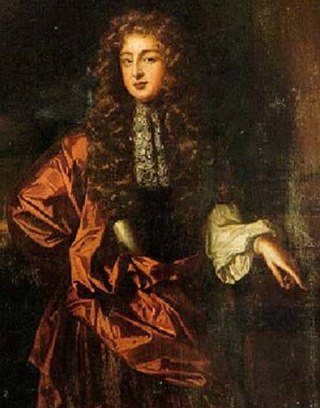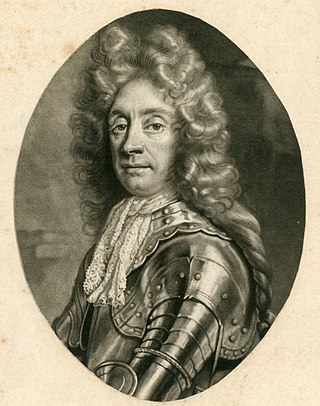Related Research Articles
Dempsey is a surname of Irish origin.
Viscount Clanmalier, in the King's and Queen's County, was a title in the Peerage of Ireland. It was created on 22 December 1631 for Sir Terence O'Dempsey, Sheriff of Queen's County in 1591 who was knighted in 1599. He was made Baron of Phillipstown, in the Queen's County, at the same time, also in the Peerage of Ireland. His grandson, Lewis, the second Viscount, joined the Irish Rebellion of 1641 and was consequently attainted with his titles forfeited. However, in 1662 he was restored to a third of his former estates and presumably to his titles. His son, Maximilian, the third Viscount, was Governor of King's County. It is believed that Terence O'Dempsey, the youngest son of Maximilian fled Ireland with his cousin Sir John Byrne to England. The actual velum title document still exists.

Claud Hamilton, 4th Earl of Abercorn PC (Ire) (1659–1691) was a Scottish and Irish peer who fought for the Jacobites in the Williamite War. He went with King James to Derry in 1689 and tried to negotiate the surrender of the town with Adam Murray. He raised a regiment of horse that he led in the defeats of Newtownbutler in 1689 and Aughrim in 1691. He was killed when the ship that should have brought him to France was intercepted by a Dutch privateer.

Henry Luttrell was an Irish army officer known for his service in the Jacobite cause. A career soldier, Luttrell served James II in England until his overthrow in 1688. In Ireland he continued to fight for James, reaching the rank of General in the Irish Army.

Theobald Dillon, 7th Viscount Dillon of Costello-Gallin supported King James II, was attainted on 11 May 1691, and fell in the Battle of Aughrim during the Williamite War. His attainder was reversed in favour of the 8th Viscount on 20 June 1694.

Henry Dillon, 8th Viscount Dillon was an Irish soldier and politician. In 1689 he sat in the Patriot Parliament. He fought for the Jacobites during the Williamite War, defending Galway against Ginkel and surrendering it in 1691 after a short siege. He obtained the reversal of his father's attainder in 1696 recovering his father's lands.
Sir Maurice Eustace, 1st Baronet was an Irish gentleman, the only holder of the Eustace Baronetcy of Castle Martin in County Kildare, which was created for him in the Baronetage of Ireland on 23 December 1685.
Felix O'Neill, also known as Phelim, and in Irish as Féilim Ó Néill, was a member of the Clandeboye O'Neill dynasty, and the ancestor of the current Chief of this Catholic Lineage.

Colonel Thomas Butler of Garryricken, also known as Thomas Butler of Kilcash was an Irish Jacobite soldier. He commanded a regiment, Thomas Butler's foot, during the Williamite War and fought at the Battle of Aughrim in 1691 where he was taken captive. His son John would, de jure, become the 15th Earl of Ormond.
Patrick Finglas was a leading Irish judge and statesman of the sixteenth century, who was regarded as a mainstay of the English Crown in Ireland. He was also the author of an influential "Breviat", or tract, called Of the Getting of Ireland, and of the Decay of the same, concerning the decline of English power in Ireland.
Events from the year 1631 in Ireland.
Colonel Gordon O'Neill, was an officer in King James II's Irish army who fought at the Siege of Derry, the Battle of the Boyne, and the Battle of Aughrim for the Jacobites.
John Bathe (1536-1586) was an Irish lawyer and statesman of the sixteenth century. He held several important offices, including that of Attorney General for Ireland and Chancellor of the Exchequer of Ireland. He was a member of a prominent landowning family from County Dublin, and himself added to the family estates. His children included the Jesuit William Bathe, who was a noted musicologist.
Sir William Warren was an Irish landowner, statesman and soldier of the late sixteenth century. He is mainly remembered now for having facilitated the much-discussed marriage of Hugh O'Neill, Earl of Tyrone and his third wife Mabel Bagenal, which took place at Warren's home, Drumcondra Castle, in 1591.
Robert Ramsay was a Scottish Jacobite soldier noted for his service during the Williamite War in Ireland. A Roman Catholic and veteran of the "French Brigade" which served in the Third Anglo-Dutch War under the Duke of Monmouth, Ramsay held the post of Adjutant-General of Foot in the English Army prior to the deposition of James II in the 1688 Glorious Revolution.
Terence O'Dempsey, 1st Viscount Clanmalier was an Irish aristocrat.
Lewis O'Dempsey, 2nd Viscount Clanmalier was an Irish aristocrat of the seventeenth century.
Patrick Sarsfield was an Irish landowner and soldier of the seventeenth century noted for his role in the Irish Confederate Wars. He is best known as the father of Patrick Sarsfield, 1st Earl of Lucan, and is sometimes referred to as Patrick Sarsfield the Elder because of this.
John Talbot was an Irish landowner, politician and soldier of the seventeenth century. He played an active role in both the War of the Three Kingdoms and the Williamite War in Ireland.

Thomas Maxwell was a Scottish professional soldier.
References
- ↑ D'Alton p.108